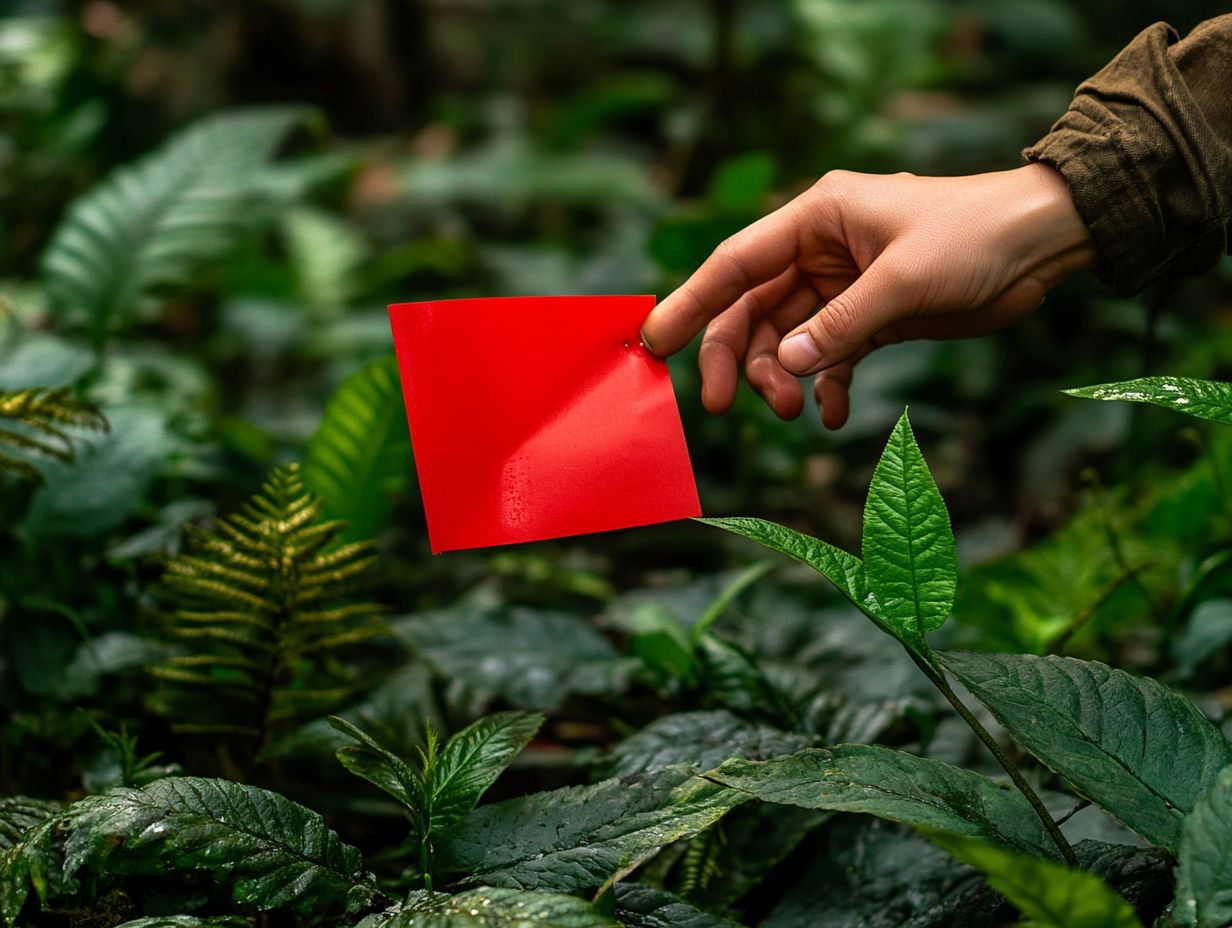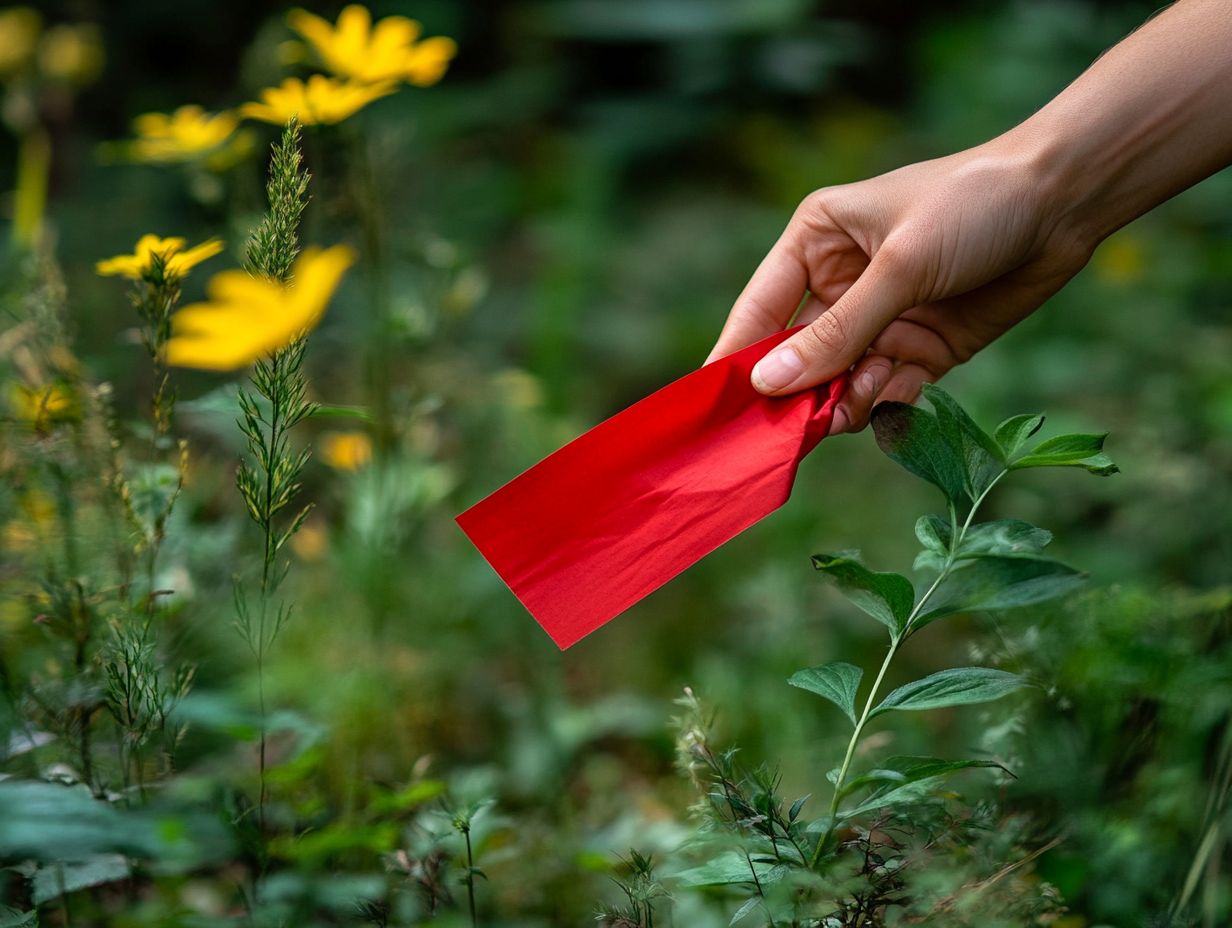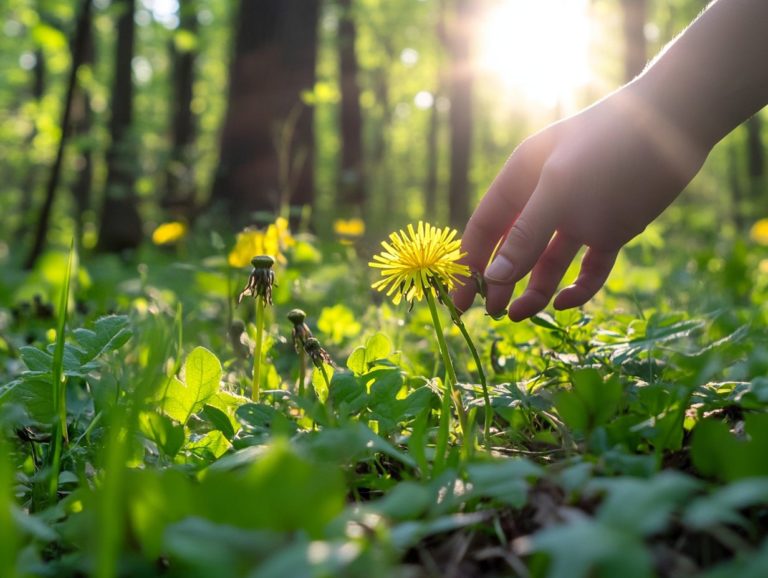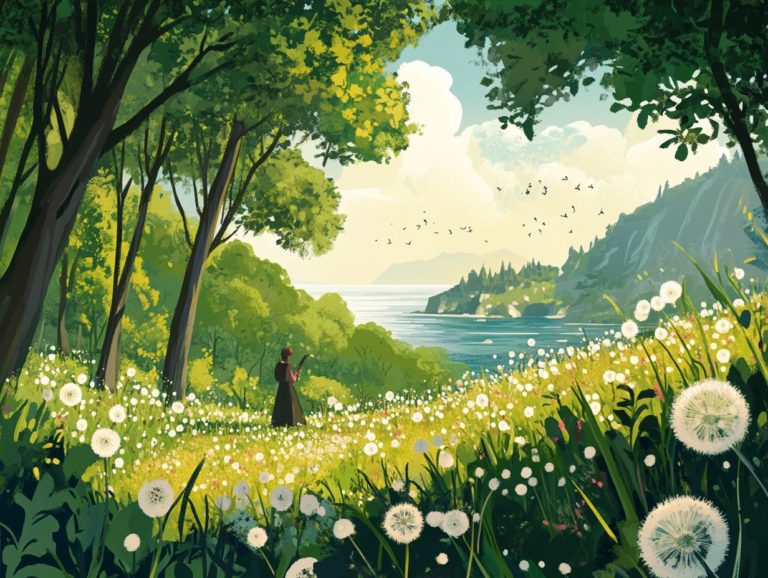10 Common Mistakes in Plant Foraging
Foraging presents a rewarding and enriching experience, connecting you to nature and unveiling the bounty the wild has to offer. This is especially important as many seek alternatives during the coronavirus pandemic.
However, it’s all too easy to stumble into pitfalls that can dampen the joy of foraging or even pose risks to your health and the environment particularly for beginner foragers.
Discover the ten critical mistakes foragers make so you can avoid them and forage safely! From getting plants wrong to overlooking sustainable practices, such as failing to recognize plant families, this article highlights what you need to know.
Whether you re a seasoned forager or just beginning your journey, grasping these missteps is essential for ensuring a safe and fruitful adventure in the wild.
Contents
- Key Takeaways:
- 1. Not Properly Identifying Plants
- 2. Not Knowing When and Where to Forage
- 3. Foraging on Private Property
- 4. Not Obtaining Proper Permits
- 5. Not Following Sustainable Foraging Practices
- 6. Foraging in Polluted Areas
- 7. Not Properly Cleaning and Preparing Foraged Plants
- 8. Not Being Aware of Poisonous Plants
- 9. Overharvesting
- 10. Not Sharing Knowledge and Resources
- Why Is Proper Plant Identification Important for Foraging?
- Frequently Asked Questions
Key Takeaways:

- Properly identifying plants is crucial for safe and successful foraging.
- Know the laws and regulations for foraging in your area.
- Always obtain proper permits and follow sustainable foraging practices to protect the environment.
1. Not Properly Identifying Plants
Getting plants wrong can be one of the most critical mistakes you make on your foraging adventures. This is particularly true given the growing interest in wild edible plants driven by food security concerns during the coronavirus pandemic. To avoid pitfalls, it’s essential to understand common mistakes in foraging, as misidentifying can lead to serious dangers, such as consuming poisonous plants or harmful wild mushrooms.
That s why correctly identifying plants using reliable resources, like Peterson s guide, is essential for anyone venturing into foraging, especially in diverse regions like Maine, New England, and California.
To become proficient in foraging, learn various methods of plant identification. Using both scientific and common names can significantly enhance your understanding and communication about specific species. This helps you differentiate between edible greens and poisonous plants, fostering safer foraging practices.
As a beginner forager, focus on distinguishing features such as leaf shape, flower color, and growth patterns to differentiate between herbaceous plants like dandelion greens and woody plants like blackberries. Pay attention to the habitat; for instance, dandelions often thrive in disturbed soils, while blackberries prefer thickets.
Join local foraging groups to gain hands-on experience and insights from seasoned foragers, enriching your journey into the world of wild edibles.
2. Not Knowing When and Where to Forage
Understanding the optimal times and locations for foraging is essential to maximize the potential of wild edible plants. This is especially true in urban areas where access to fresh food can greatly enhance your food security, particularly during the pandemic.
For instance, when spring rolls around, expect a delightful bounty of tender greens like dandelion and chickweed. As summer arrives, vibrant berries such as blackberries and raspberries are ripe for the picking. Then, as fall settles in, mushrooms like chanterelles and puffballs flourish, offering distinct and exciting flavors.
Make it a priority to familiarize yourself with local regulations, as some areas allow foraging while others impose strict restrictions to protect native species. Engaging with community resources like foraging workshops or local botanical clubs provides invaluable insights into safe practices and sustainable harvesting methods.
This knowledge enables you to explore the rich edible landscape your city has to offer.
3. Foraging on Private Property
Foraging on private property without permission is not only illegal; it can create friction within the foraging community. It’s crucial to respect property ownership while searching for wild edible plants.
By asking landowners for permission, you can build trust and goodwill essential elements for positive relationships in your local area. Friendly conversations with landowners can open avenues for collaboration, such as exchanging insights about local flora or participating in community events.
Cultivating connections within the foraging community enhances your opportunities for memorable foraging adventures. It also helps create a network of like-minded individuals who support ways to collect plants that don t harm the environment. This respectful approach can enrich your foraging experiences and contribute to preserving our precious natural resources.
4. Not Obtaining Proper Permits
Failing to secure the appropriate permits for foraging can lead to legal consequences, undermining the collective efforts of the foraging community to champion sustainable practices and food security.
Each region has its own regulations regarding foraging, especially in state parks or protected areas where the ecosystem is delicate. You may need permits to collect edible plants, mushrooms, or fruits in conservation areas. If you’re eager to forage, knowing the local laws is crucial!
By understanding these rules, you help protect native species and cultivate a culture of responsible foraging. This ensures that valuable resources remain accessible for future generations.
Check local regulations today to start your foraging journey responsibly!
5. Not Following Sustainable Foraging Practices

Not adhering to sustainable foraging practices can lead to overharvesting and the depletion of wild edible plants. This poses a significant threat to the variety of plants and animals and the delicate ecosystems that support them.
It’s essential for anyone engaged in foraging to grasp the long-lasting impact their actions have on these ecosystems. By following principles like taking only what you need and ensuring enough is left for regeneration, you can help maintain a balance that allows nature and your communities to thrive.
Spreading awareness and knowledge about these sustainable practices within the foraging community fosters a deeper respect for the environment. Engaging in workshops and discussions nurtures a collective commitment to preserving vital resources for future generations.
6. Foraging in Polluted Areas
Foraging in polluted areas can jeopardize your health, as wild edible plants and mushrooms can absorb toxic substances from contaminated soil and water. This underscores the critical importance of carefully assessing the safety of your foraging locations.
Urban pollution comes from various sources, such as industrial emissions, vehicular exhaust, and improper waste disposal. Together, these factors significantly degrade environmental quality and can adversely impact the wild plants that flourish in these settings.
To ensure your safety while foraging, seek areas away from busy highways and industrial zones. It’s best to choose locations that have been tested for contaminants. If you re new to foraging, consider exploring urban community gardens or designated green spaces. These spots are often cultivated with care and can provide a more reliable source of safe, edible plants.
7. Not Properly Cleaning and Preparing Foraged Plants
Neglecting to properly clean and prepare foraged plants can lead to foodborne illnesses and may trigger food allergies. This highlights the importance of attention to detail throughout the foraging process.
To ensure a safe and enjoyable experience with wild edibles, start by accurately identifying the plants. Rely on trusted field guides or mobile apps, and consult an expert if you’re unsure.
After harvesting, wash the plants thoroughly in cool, running water to eliminate dirt and potential contaminants. For leafy greens, a gentle soak followed by a rinse is particularly effective.
Always inspect your finds for pests or signs of decay, as these can compromise both safety and flavor. Avoid foraging in areas treated with pesticides or other chemicals, and stay informed about local regulations to protect ecosystems from harm.
8. Not Being Aware of Poisonous Plants
Being unaware of poisonous plants can have serious consequences, including illness or death. This underscores the importance of a thorough understanding of how to identify toxic species.
Among the most infamous offenders are the death cap mushroom and hemlock, which can easily be confused with benign counterparts. The death cap, for instance, is often mistaken for edible mushrooms, yet its toxic compounds can lead to liver failure without prompt medical attention.
Hemlock, with its fern-like leaves, is notorious for causing respiratory failure when consumed. Familiarize yourself with local flora, utilize dependable field guides, and, if possible, forage alongside experienced mentors.
Wear gloves to boost your foraging experience and steer clear of untrusted species for added safety.
9. Overharvesting
Overharvesting poses a significant challenge within the foraging community, threatening the depletion of wild edible plants and disrupting local ecosystems. Adopting sustainable practices is crucial for our wild plants!
The consequences of overharvesting ripple through wildlife habitats and jeopardize the delicate balance of local ecosystems. When plants are removed faster than they can reproduce, the entire food web (the interconnected system of plants and animals that rely on each other for survival) is compromised, leading to further ecological imbalances.
Here s how to forage responsibly:
- Set harvest limits
- Target only mature plants
- Selectively forage instead of stripping entire populations
Educating fellow foragers on these practices is crucial. By fostering a community understanding, you help preserve the environment and enrich the foraging community.
10. Not Sharing Knowledge and Resources

Not sharing knowledge and resources within the foraging community can stifle your growth and limit valuable learning opportunities. It minimizes the collective expertise necessary to navigate the art of foraging successfully.
When foragers come together to exchange tips, experiences, and resources, an environment rich in wisdom and support cultivates. This collaborative spirit is essential; as you explore various terrains and identify wild edibles, you gain insights that enhance your skills and those of others.
Online platforms, such as dedicated forums and social media groups, serve as excellent avenues for interaction. Local workshops and community gatherings foster important face-to-face connections. By actively participating in these exchanges, you deepen your understanding and help ensure that knowledge remains vibrant for future enthusiasts.
Don t wait join your local foraging community today!
Why Is Proper Plant Identification Important for Foraging?
Proper plant identification is essential for foraging success. It ensures that you can confidently select wild edible plants while steering clear of toxic varieties. Understanding the myths about foraging safety is more crucial than ever, especially in light of the food security concerns that emerged during the coronavirus pandemic.
Accurate identification enriches your foraging experience and invites you to explore local habitats with a sense of adventure and curiosity. By using comprehensive identification guides either in print or digital formats you can deepen your understanding of each plant’s unique characteristics, habitat preferences, and seasonal availability.
This knowledge empowers you and your community, helping communities find food when needed by encouraging the harvesting of nutritious wild foods that might otherwise remain overlooked. Ultimately, mastering proper plant identification strengthens community well-being as individuals come together to share discoveries and educate one another on sustainable foraging practices.
What Are the Best Practices for Sustainable Foraging?
Best practices for sustainable foraging protect the longevity of wild edible plants and bolster food security for generations to come. Responsible foraging is necessary.
This responsibility entails a deep understanding of the local ecosystem, which includes plants, animals, and their interactions. You can cultivate this understanding through community workshops and educational resources designed to foster an appreciation for native flora.
By embracing respectful harvesting methods such as only taking what you need and ensuring there s enough left for wildlife and natural replenishment you actively contribute to ecological balance.
This commitment supports sustainable practices, allowing human activity and nature to thrive together. As a result, foraging remains a vital resource for future communities.
Engaging with local communities in these practices strengthens social bonds and fosters a sense of collective stewardship over shared natural resources.
What Are Some Common Poisonous Plants to Avoid?
Awareness of common poisonous plants is essential for foragers like you. Misidentification can lead to serious health risks, so it s important to familiarize yourself with both their common names and scientific names.
Take Virginia creeper, for example. Its distinctive five-leaf clusters can easily be mistaken for harmless vines, so knowing how to identify it is crucial for your safety in the wild.
Another example is the Jerusalem cherry, with its bright red berries and shiny green leaves. This plant is particularly misleading, luring in the curious despite its toxicity. Educating yourself about these plants is vital; it will help you steer clear of dangerous encounters.
Understanding not just how these plants look, but also where they thrive, allows you to cultivate a deeper respect for nature while protecting your health and that of others.
How Can One Safely and Ethically Forage on Private Property?
To forage safely and ethically on private property, always get permission from the landowner and adhere to established guidelines. This fosters positive relationships within the foraging community.
Start by approaching the landowner with genuine respect and appreciation for their property. Clearly communicate your intentions, explaining what you plan to forage and how it benefits both you and the local ecosystem.
Offering to share your knowledge about foraging and perhaps even providing a portion of your harvest can showcase your goodwill and collaborative spirit. Listen to any concerns they may have, ensuring their comfort while respecting the integrity of their land.
By taking these steps, you navigate the complexities of private land use and contribute to cultivating a culture of trust and respect in the foraging community.
What Are Some Ways to Preserve and Use Foraged Plants?

Understanding how to preserve and utilize foraged plants is essential for getting the most nutrition out of them and savoring the unique flavors of wild edible greens throughout the year.
By mastering techniques such as drying, freezing, and canning, you can ensure that nature’s bounty isn’t lost to the changing seasons. When you dry herbs like wild thyme or stinging nettle, their flavors become concentrated, making them ideal for seasoning dishes during the colder months.
Freezing tender greens like lamb s quarters or dandelion leaves allows you to effortlessly incorporate them into smoothies and soups all year long.
Canning seasonal berries turns them into delicious jams or jellies, providing a sweet reminder of nature’s gifts even as frost blankets the ground. Exploring diverse recipes not only elevates your cooking experiences but also deepens your appreciation for the foraged treasures awaiting discovery in your local landscape.
What Are Some Resources for Learning More About Foraging?
There are plenty of resources at your fingertips if you’re eager to delve into the world of foraging. Consider picking up a book like Peterson s guide, or explore online communities brimming with valuable insights tailored for beginner foragers.
Local workshops often provide hands-on experiences that let you get acquainted with edible plants right in your own backyard. Websites dedicated to foraging enthusiasts serve as treasure troves of information, offering articles, user-submitted photos, and identification tips that can significantly enhance your understanding.
Joining social media groups can spark engaging discussions and create opportunities to connect with seasoned foragers who are more than willing to share their wisdom. Dive into this vibrant community, and refine your foraging skills while building a network of like-minded individuals who share your passion for the wonders of nature.
Check out this helpful video on foraging!
Frequently Asked Questions
What are the most common mistakes people make when foraging for plants?
1. Not properly identifying the plant: One of the biggest mistakes in plant foraging is mistaking a toxic plant for an edible one. To avoid this, be aware of the 5 common mistakes new foragers make and always make sure to properly identify the plant before consuming it.
2. Not gathering enough information: Before consuming a new plant, it’s important to research its properties, potential side effects, and proper preparation methods. Following the top 5 tips for successful foraging can help you avoid any mistakes.
3. Not knowing the seasonality of plants: Know which plants are safe to eat during their season to avoid any potential health risks.
4. Not knowing the difference between look-alike plants: Many edible plants have poisonous look-alikes, so it’s crucial to know the distinct characteristics of each plant to avoid any confusion. Following 10 tips for successful summer foraging can help you stay safe while exploring.
5. Foraging in polluted areas: Plants can absorb toxins from their surroundings, so it’s important to avoid foraging in areas that may be contaminated by chemicals or pollutants. For more information, check out the 5 best practices for safe seasonal foraging.
6. Not obtaining permission: It’s important to respect private property and obtain permission before foraging on someone else’s land. Not doing so can lead to legal trouble or potential harm from pesticides or other chemicals. For those interested in foraging, following 10 tips for identifying edible plants can also enhance your experience.
What are some safety precautions to take when foraging for plants?
1. Wear long sleeves, pants, closed-toe shoes, and gloves to stay safe from thorns and ticks.
2. Bring a guidebook or a knowledgeable friend. This helps ensure you identify plants correctly.
3. If you’re new to foraging, start with a small amount. Wait 24 hours before eating more to watch for bad reactions.
4. Wash all plants thoroughly. This removes dirt, bugs, and any possible toxins.
5. Only take what you need. Protect the plants and their environment for future foragers.
6. If you notice any bad reactions, seek medical help right away!






